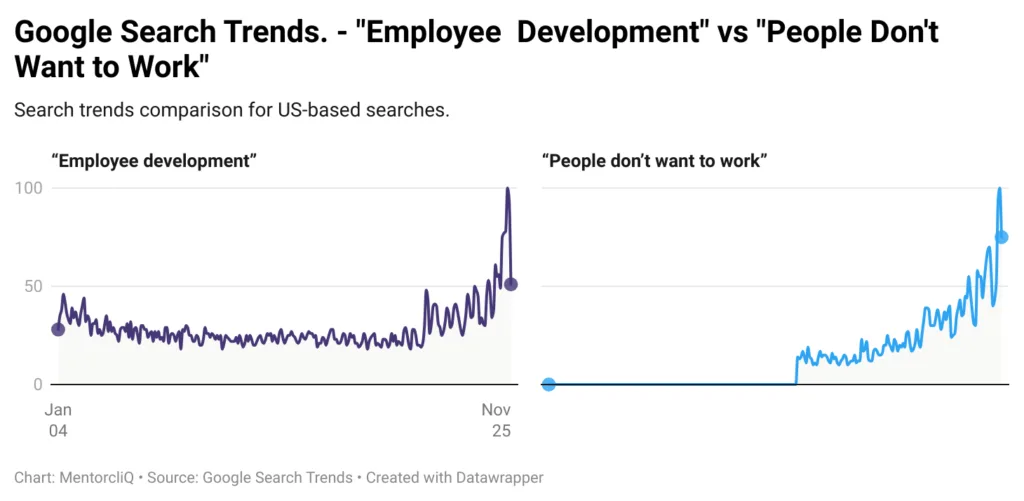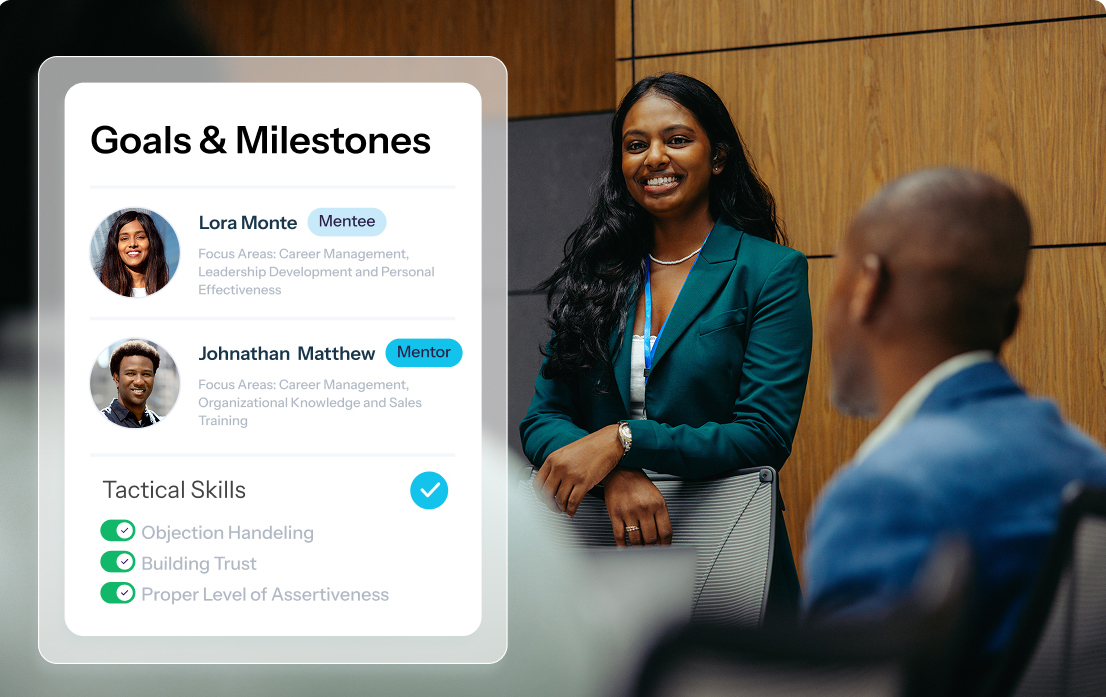Career mapping is a career planning activity that involves visually planning the direction of an employee’s desired career path. Many companies are leaning into the concept of career mapping as a way to help boost employee engagement and development during a time where worker productivity has tanked.
Despite the rough job market in the past few years, many companies are still struggling with low productivity rates and high turnover. Often, though, the issue isn’t that people don’t want to work, but that they want to see where their work is going to take them. This is why career mapping is an essential way to boost employee engagement and retention.

Rather than having unhelpful conversations about how no one wants to work anymore, employers (and this is a bit of a bitter pill to swallow) should focus their efforts on supporting a workforce that will not be with them for their whole working lives.
Career mapping is a process that HR and talent development leaders can implement to have honest and open discussions with employees about their future career paths and internal mobility within the company. With effective career mapping practices in place, employees can more easily see the path forward within your organization. When they can see that path, they’re far more likely to take that journey with you than one of your competitors.
What Is Career Mapping?
A career map is a plan for where an employee wishes to go in life. No matter their ambitions or what they wish to achieve in their career, this tool can help them visualize the path ahead of them. When combined with structured career goals, a career map creates a visual and effective plan around moving from one position in the organization to another, whether that movement is upward or sideways.
That’s an important point to reiterate, and one that Mentoring Luminary award winner Jodi Davidson, Vice President of Global Diversity Equity & Inclusion at Sodexo, made in a post about Well-Being and Culture:
“In today’s climate, it really is about superseding the proverbial “career ladder of success.” Instead of mentoring being made available solely for the “HIPO” that was only looking up, we can reach a far greater critical mass who recognize the multi-directionality of that same ladder.”
3 key questions to ask about career mapping
Career mapping can be broken down into just three questions:
- Where am I now?
- Where do I want to go with my career?
- What do I need to do to get there?
If you can answer these questions, you have the most basic of career maps ahead of you, ready to be fleshed out and further detailed. Rather than dive straight into the technical aspects of a career map, like soft skills and knowledge gaps, sometimes it is better to look at the simple questions. With a perspective on the basics, you can then begin to think in more depth about the direction you’d like your career to move.
Take it with you:
Download your FREE Career Mapping exercise to help guide yourself or others through the process
Why career mapping matters
Imagine one of your employees is sitting in a performance review. The career conversation is flowing smoothly, when suddenly their manager leans forward, locks eyes with them, and poses one of those many questions employees fear:
“Where do you see yourself in 5 years?”
If employees don’t have a good answer to this question, it can negatively impact their performance review. Managers may perceive them as having less ambition and less confidence; that’s negatively associated with staying in the same spot for longer.
There are also distinct DEI concerns at play. Women and BIPOC workers are often seen as having less potential and tend to receive fewer promotions. This ultimately creates wage gaps that are hard to ignore. One of the reasons for this is a lack of mentors who can help these employees not only map out what they want but also confidently speak about those wants during performance reviews.
Few people get a job out of college and stay there these days. That’s not to say employees have no desire to stay at all. But if the only clear way up is out, employees tend to choose the out option.
Career Mapping vs Career Pathing: Are They the Same?
Some organizations do use the phrases career mapping and career pathing interchangeably, and they are indeed very similar concepts. Both do require some thought and planning around professional development and how a worker might wish to achieve a certain level of authority in their industry. However, there is a slight and subtle difference between them:
- Career mapping is the process in which specific career paths are identified and outlined to help a specific employee based on their goals
- Career pathing is the process of defining a logical progression through roles to reach an end goal
So, the career mapping process can be considered to be a lot more holistic than career pathing. Pathing might also be limited to being just within one company or industry, while mapping might be used to plot a course across someone’s entire projected working life, accounting for changes in industry, promotions, and even potentially career breaks.
What Is the Role of the Employer in Career Mapping?
If career mapping is a tool for the benefit of employees, where does the employer or manager come into it? The whole point of career mapping is to visualize someone’s entire career journey. If people are only staying at a certain company for just a handful of years, then what’s the value to your organization if you are setting the employee up for success somewhere else?
That’s the wrong mindset to have and one that will lead to more turnover, not less.
You need to engage your employees. One study from Gallup found that highly engaged employees have a 23% higher profitability and 21% less turnover in high-turnover organizations and 51% in low-turnover ones.
When you provide employees with both a roadmap to success and development programs that that help them talk communicate their value more clearly, you can more easily retain them. And thats only on the soft skills front. When you help them develop their technical skills, as well, you not only make them more valuable to your company, but make them far likelier to succeed when they get promoted or move into new positions.
Career mapping often points to leadership development. Here’s a quick video on how to use mentoring in a leadership development program.
The benefit of career mapping for employers is that it can often align with organizational goals and objectives.
By having a clear career progression framework throughout the company, senior management can better define job descriptions and workloads, allowing for a fair delegation of responsibilities and tasks.
In turn, this should boost employee retention and job satisfaction as employees have a full understanding of what is expected of them in their role. KPIs are more easily met, and employees can feel empowered to fully embrace their potential and take on new tasks where possible.
What’s more, career mapping should be facilitated by employers as it helps to show employees the full spectrum of development opportunities available to them. Career mapping can be a valuable tool for mentors to use to show their mentees the paths they could pursue if they decide to stay with the company. This, in turn, can help decision-makers and administrators show where budgets need to be allocated and how the hiring process may need to be refined.
How to Create Career Maps as an Employer
Management needs to take the lead in creating career maps and paths, supporting employees and giving them clear routes to advancement. By creating employee career paths and openly discussing opportunities within the company, there is a greater chance of influencing workers to choose these paths.
Let’s take a closer look at what employers and managers can do when creating a career mapping strategy.
1. Assess your business or organizational needs
To accurately build employee career paths and a career mapping initiative, management needs to consider the overall needs of the entire organization. Questions that might be included during this audit could include but are not limited to:
- What are the plans for future growth?
- Do organizational objectives need to change to meet these goals?
- Will new roles emerge to help facilitate these plans?
- Can these new roles be filled internally, and if so, are there skill gaps to address prior to advancement?
From these findings, management should be able to create effective career pathing across the business. For all jobs—both current and predicted—try to create accurate job descriptions with clear lists of essential and desirable skills and experience. From this, transferable skills should emerge. These are the areas that employees should be encouraged to work on through training and development opportunities, as they can best aid in moving up the internal career ladder.
2. Consult employees
Employees will always be a key part of any career mapping exercise. If they refuse to interact with it, then it should be obvious that they see no viable career path open for them within the company.
By consulting employees, you will have a clearer picture of their career goals.
- What do they consider to be a dream job?
- Is it a role that you can offer within your company?
- Are they a likely candidate to step into this role one day, and what can the organization offer to help them reach this objective?
At this point, it can be a great idea to analyze the soft skills of the entire team to discover if there are any major skill gaps. Whether we rise up career ladders or move laterally through departments, proficiency in soft skills will always aid us, even as we adapt new technical skills as our tasks and responsibilities transform. Employers need to be mindful of the skills employees wish to develop as part of their career progression so that their goals can successfully align with that of the company as a whole.
3. Build personalized career development goals

Every employee will have their own career aspirations and an idea of the goals they wish to achieve across their career. Now that employers have an idea of the career paths that exist within their company, they can begin to create a personalized career development plan for each employee.
This will take into account the career pathing already routed through the business. An employee may decide that they wish to follow one of the established career paths set out by the business, or they may have aspirations to move on to a new role elsewhere. Both viewpoints ultimately should be respected.
Remember, a career path is not always the most linear to follow. Some people will decide to retrain or move to another department, others might take a demotion, and some might decide that they wish to stay in their current role (and that’s totally fine!). No matter what their future aspirations might be, the aim should be to create a career map that aligns both the goals of the employee and the company.
4. Establish development programs
With a list of goals and objectives to achieve, the employee can then be prepared to undertake whatever upskilling and learning might be needed to get them where they need to be. From learning courses to certifications, many options exist when it comes to pursuing growth opportunities and learning more. Often, it is within employee development programs that we learn where our true passions in the workplace lie.
Mentoring can be a fantastic tool to use here as part of a career development program. Since it frequently involves the exchange of knowledge and understanding, plus practical applications from lived experiences, it is easy to see why a mentoring relationship can be used to shape a career path. A mentee may choose to work alongside a particular mentor because the latter has laid out a career map that the mentee wishes to emulate.
If you’re looking to implement a mentoring program, you’re in for a treat! Check out our detailed guide on how to start a mentoring program.
5. Monitor progress
Finally, any progress along a career map should continuously be monitored and supported by the company to ensure that the alignment between personal and organizational goals is adequately balanced.
Sometimes, we can start down one path and realize that it is not the right one for us. We might enter the workplace with all the daydreams about what our ultimate goal and career progression might look like. However, the reality can be quite different.
This is again where the power of mentoring can come into play. Offering the mentee someone to lean on and provide guidance where needed can help empower them and begin to think about what a new career path could potentially look like as well as give them someone to celebrate the wins with.
What Does a Career Map Template Look Like?
- Starting Position: Job title and full description of role
- Other skills and experiences currently held
- Personality profile
- S.M.A.R.T. Goal 1 and how it is of benefit
- S.M.A.R.T. Goal 2 and how it is of benefit
- S.M.A.R.T. Goal 3 and how it is of benefit
- Ending Position: Job title and full description of role
We’ve listed three S.M.A.R.T. goals in the template above to get you thinking, but anyone filling out the template can use as many or as few as they like. You could also add in other positions along the way to help you better visualize the steps that you would need to take to reach this ultimate objective.
Think about them like strides down a garden path. Some people might take more and others need fewer. In a business setting, an intern dreaming of life in the C-Suite is going to need to take a few more steps than someone who is already in a middle management position and looking further up the corporate ladder.
A Career Mapping Example – Marketing Assistant to Manager
Let’s quickly dive into what an example of career mapping might look like. This is just a quick example to give you some quick inspiration based on the above template – a real career map might look a lot more in-depth!
- Starting Position: Marketing Assistant, responsible for managing the company’s social media posts and community engagement
- Other skills and experiences currently held:
- Bachelor’s degree in Marketing
- proficiency in social media management
- basic graphic design skills
- Personality profile: Detail-oriented, creative, strong communication skills
- S.M.A.R.T. Goal 1
- Enhancing social media management skills
- Contributing to the development of comprehensive marketing campaigns
- Obtaining certification in advanced social media marketing
- S.M.A.R.T. Goal 2
- Attend workshops on graphic design to improve design skills
- strengthening graphic design abilities
- Contributing to creating visually appealing marketing materials
- S.M.A.R.T. Goal 3
- Developing leadership skills
- Gaining experience in project management
- Taking on a leadership role in coordinating a small marketing campaign
- Ending Position: Social Media Manager, responsible for overseeing the company’s social media, delivering strategies to increase engagement, and planning campaigns
Additional skills and experiences acquired along the way might include the completion of project management training, a successful lead on multiple marketing campaigns, and the gain of a leadership certification.
Build Career Mapping into Your Business and Mentoring Framework
Businesses should be supportive of their employees’ personal growth and goals. By working with them to create a career map, management can ensure that workers’ professional goals align with the overarching goals of the organization.
To create a working environment with plenty of internal leadership positions and career opportunities, employees need the motivation to stay in their current positions and consider how their professional aspirations can best be facilitated by and from within.
Career mapping can form an ideal discussion for a workplace mentoring program. Career goals may initially seem out of reach to employees, but the right mentor can change everything. Our research shows that 83% of clients said mentoring positively influenced mentees’ desire to stay at their organization. We suggest that any mentor start with creating a career map example based on their own career so they can first get a feel for the goals it inspires.
No career path runs straight and true. A mentor stands beside their mentee, celebrating the wins and evaluating the losses, and helps them to navigate any twist or turn that might be sent their way. No matter what their career goals might be, their current place of work should always look to support them.
Are you ready to shape your employees of today into the leaders of tomorrow, no matter where their career map might take them? Book a demo with MentorcliQ now to see how you can plot a journey towards engaged and empowered workers confident in where their careers can grow.




